Optimization of the Concentrated Inspection Campaign Model to Strengthen Port State Control
Abstract
1. Introduction
2. Literature Review
2.1. Selection of PSC Inspected Ships
- Local improvement of the existing ship selection mechanism:
- 2.
- Improving identification of substandard ships:
- 3.
- Overall optimization of the ship selection model:
- 4.
- Identifying critical elements for the selection of substandard ships:
2.2. Analysis of the PSC Detention Ship Deficiency
- To improve the efficiency of PSC inspection and avoid ship detention, Ran Yan et al. [13] used Smart Predict then Optimize (semi-SPO) to improve the efficiency of PSCO inspection and avoid ship detention with limited resources. Ran Yan et al. [18] used the association rule to find the correlation between deficiency codes in the PSC inspection of detained ships to improve the efficiency of PSCO inspection. Ke-Zhong Liu et al. [19] used the Paris MoU PSC database from 2017 to 2020 and built a Bayesian-based machine learning approach model that was developed to find more efficient ways to avoid ship detention from the ship owner’s standpoint.
- Critical elements from PSC inspections of ship detention: Through traditional statistical analysis of Black Sea MoU deficiency records from 2012 to 2017, Şengül Şanlıer [20] identified 10 critical elements of PSC inspection of ship detention. Li-Xian Fan et al. [21] used Tokyo MoU deficiency records from 2000 to 2016 to first set 23 PSC inspection deficiency categories and parameters such as ship age, gross tonnage, and ship type, and then used Bayesian networks to explore the PSC inspection deficiency elements related to ship accidents. Ji-Hong Chen et al. [4] calculated the weight of the deficiency item factor for PSC ship detention using the entropy weighting method and GRA with the annual report of Tokyo MoU from 2008 to 2017. Chien-Chung Yuan et al. [22] cited the database of PSC inspection deficiency items and causes of ship detention in Keelung, Kaohsiung, and Hualien ports from 2015 to 2018 and analyzed 18 types of PSC inspection deficiency for ship detention using cause-and-effect analysis. Zhu, J. H. et al. [23] used inspection data from Paris MoU and Tokyo MoU to project the critical deficiency items that affect inspectors’ opening of ship detentions by using a cloud-based big data model with a subjective in-decision-maker’s rule of thumb.
- The correlation between deficiencies in PSC inspection of ship detention: Ming-Cheng Tsou [24] used the Tokyo MoU PSC inspection database from 2000 to 2016 to find the correlation among deficiency codes and the combination of PSC inspection items with causal correlation using association rule mining techniques. Ran Yan et al. [18] identified the correlation between deficiency codes of detained ships using the association rule model. Ji-Hong Chen et al. [4] identified the correlation between deficiency items for PSC ship detention using the entropy weighting method and GRA with annual report data of Tokyo MoU from 2008 to 2017. Junjie Fu et al. [25] used the Tokyo MoU deficiency database from 2014 to 2018 to calculate the likelihood of simultaneous occurrence of different PSC deficiency codes through the data quality procedure enhanced apriori algorithm (DQCPEA) model and the correlation between items. Çelik, B. and Çakır E. [26] collated 12 deficiency types using data examined from 2018 to 2021 in the Black Sea MoU with entropy-based grey relation analysis and association rule mining (ARM) methods. Examining the frequency of detection of different deficiency types before and after COVID-19 demonstrates the close relationship between ISM and DoC (Document of Compliance) during an epidemic, and suggests a response plan for PSC during a pandemic.
2.3. The Correlation between Ship Types and Deficiency Codes for PSC Ship Detention
2.4. Ship Risk Assessment
- Ship Risk Assessment Indicators:
- 2.
- Improved NIR Inspection Mode:
2.5. Other Literature on Exploring PSC
- Examine the effectiveness of current and historical CIC enforcement items in combating substandard ships.
- 2.
- PSC inspection items are numerous and multifaceted; PSCO professionalism and law enforcement awareness are not the same.
- 3.
- The focus of CIC inspection is a single series, and the decision is made by using the largest number of deficiency data from the previous year’s PSC inspection, so the execution of the CIC inspection is not prompt. This research method can be built mathematically or with corresponding software, and the top three items with the highest number of deficiency records in each of the last three years can be entered into the rolling CIC inspection system to solve the problem of timeliness.
- 4.
- The focus on the cumulative number of major deficiency items in PSC is concentrated into a single or a few deficiency series every year. It is easy for minor common deficiencies to pass detection if the composite CIC deficiency code check series is not used.
3. Methodology
3.1. Study Overview (Figure 1)

3.2. Grey Relational Analysis
3.3. Technique for Order Preference by Similarity to Ideal Solution
3.4. Three-Sigma Rule
4. Data Analysis
4.1. Information Collation
4.2. GRA Analysis
4.3. TOPSIS Analysis
4.4. Three-Sigma Rule Analysis
5. Discussion
5.1. Deficiency Codes
5.2. Ship Types
5.3. Recommendations
6. Conclusions
Author Contributions
Funding
Institutional Review Board Statement
Informed Consent Statement
Data Availability Statement
Conflicts of Interest
Abbreviations
| Codes | Definition |
| 01000 | Certificate and Documentation |
| 02000 | Structural Conditions |
| 03000 | Water/Weathertight conditions |
| 04000 | Emergency Systems |
| 05000 | Radio Communications |
| 06000 | Cargo operations including equipment |
| 07000 | Fire safety |
| 08000 | Alarms |
| 09000 | Working and Living Conditions (09100/09200) |
| 10000 | Safety of Navigation |
| 11000 | Life-saving appliances |
| 12000 | Dangerous goods |
| 13000 | Propulsion and auxiliary machinery |
| 14000 | Pollution prevention |
| 15000 | ISM |
| 16000 | ISPS |
| 18000 | 2006 MLC |
| 99000 | Others |
Appendix A

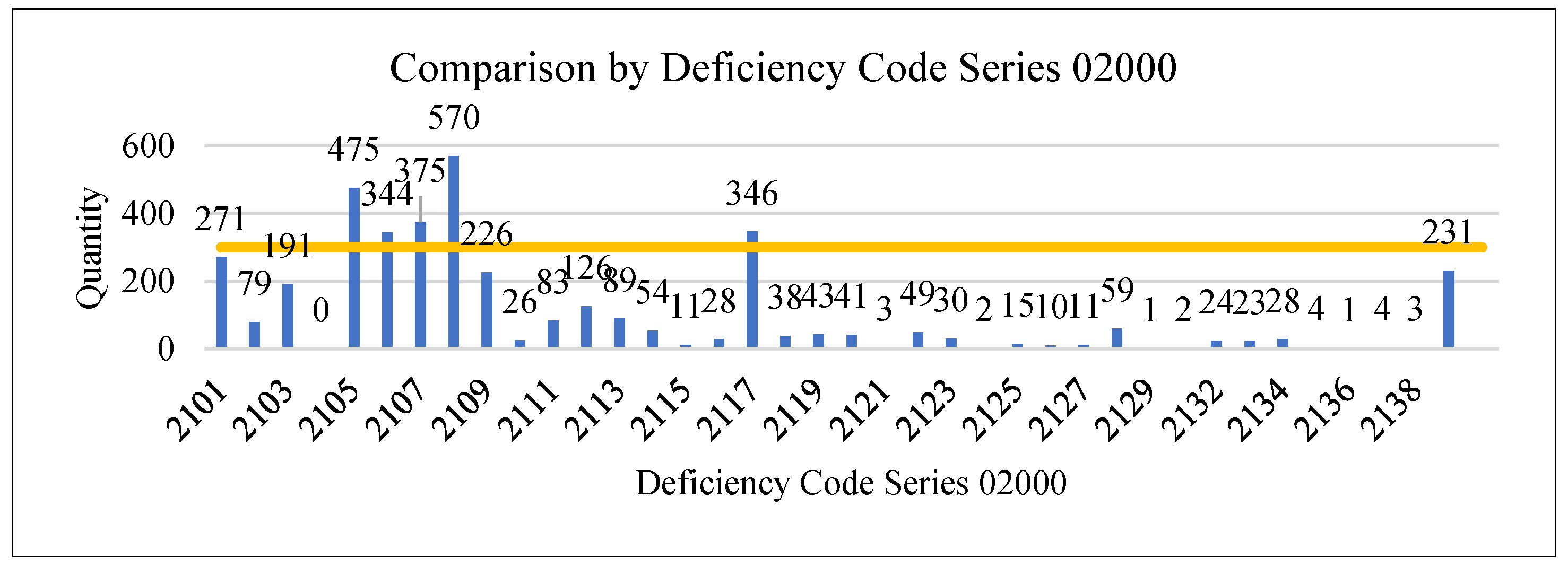





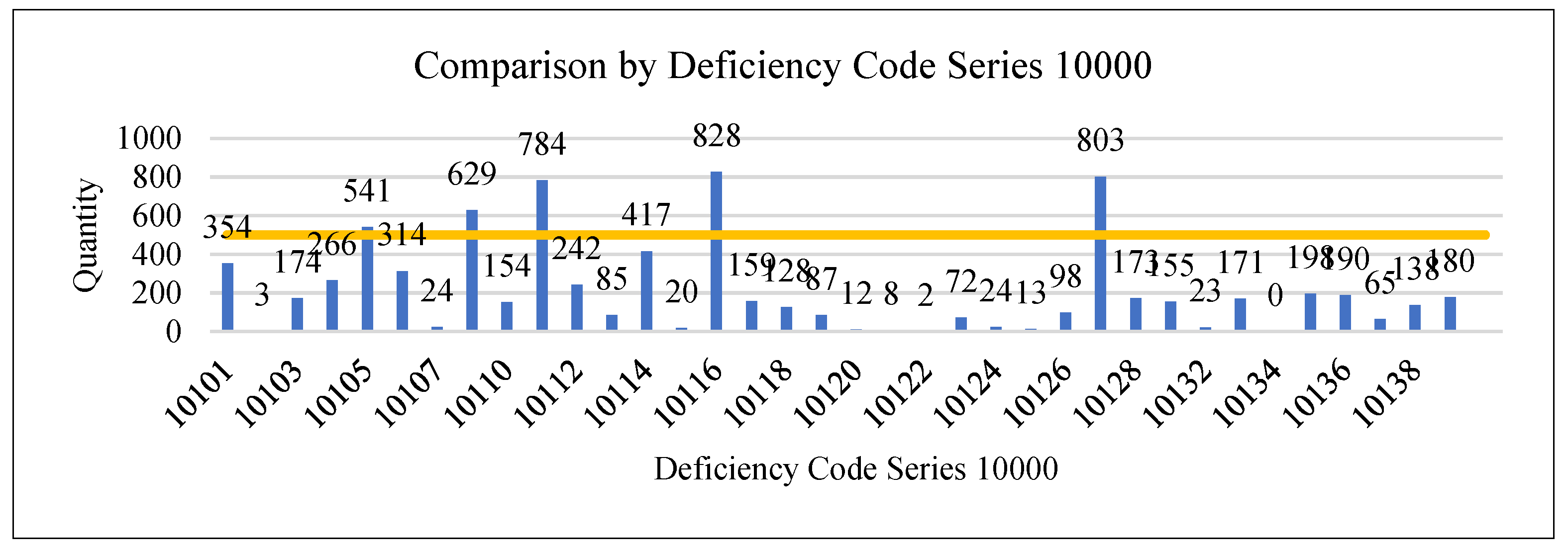



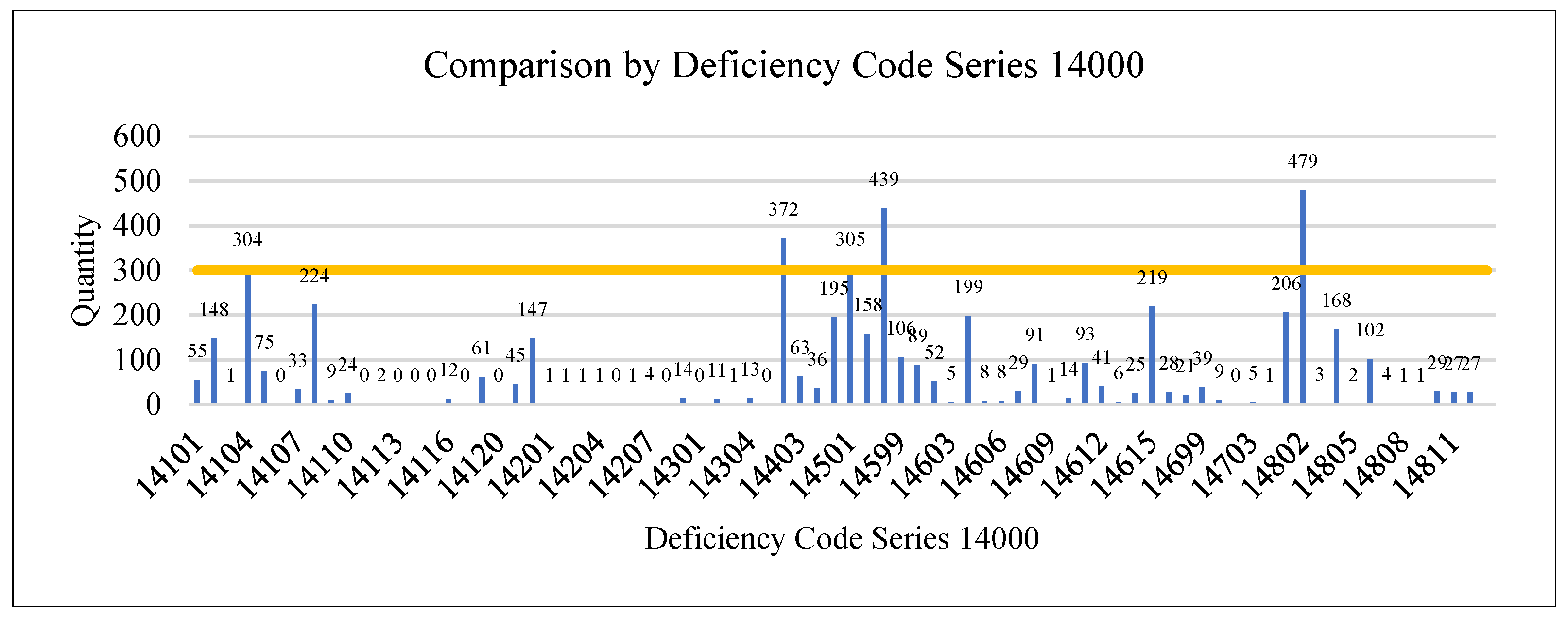

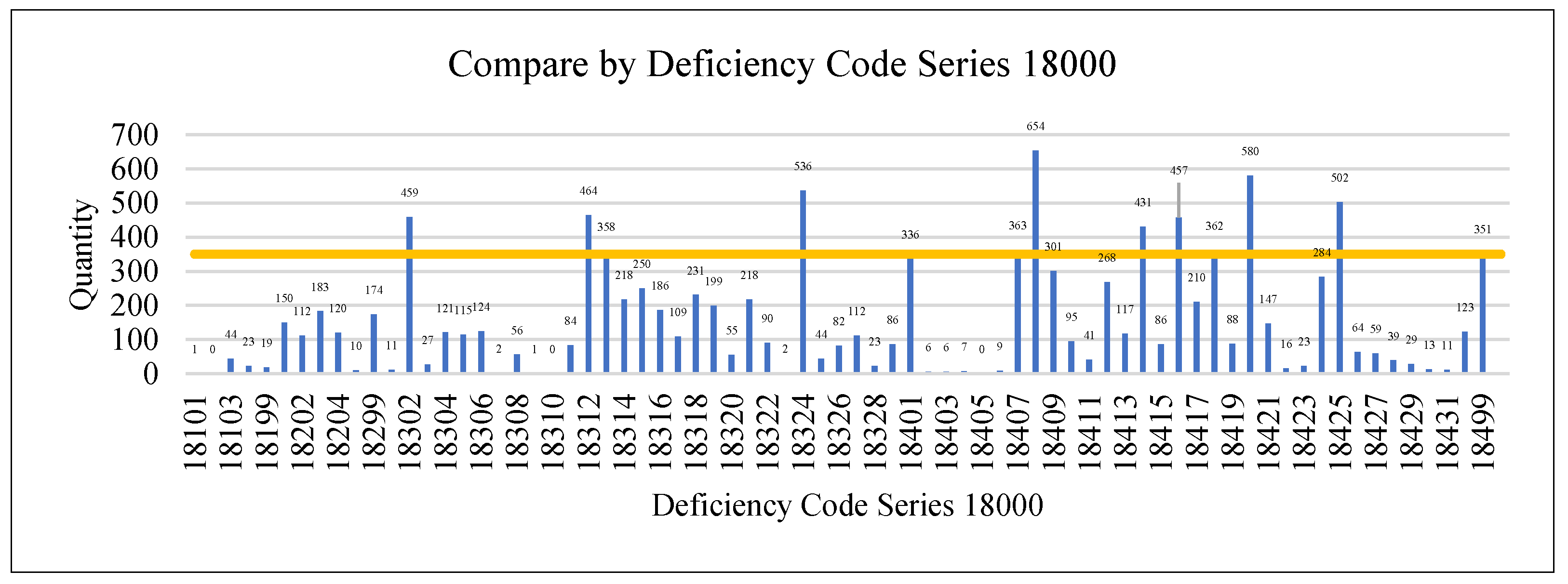

References
- IMO-Port-State-Control. Available online: https://www.imo.org/en/OurWork/MSAS/Pages/PortStateControl.aspx (accessed on 25 January 2023).
- Paris MoU. Available online: https://www.parismou.org/ (accessed on 25 January 2023).
- The Paris MoU New Inspection Regime. Available online: http://www.vanuatumaritimeships.com/Documents/NIR%20TOKYO-PARIS%20MOU.pdf (accessed on 25 January 2023).
- Chen, J.H.; Zhang, S.H.; Xu, L.; Wan, Z.; Fei, Y.J.; Zheng, T.X. Identification of key factors of ship detention under Port State Control. Mar. Policy 2019, 102, 21–27. [Google Scholar] [CrossRef]
- Shen, J.H.; Liu, C.P.; Chung, K.Y.; Chen, Y.W. Ship Deficiency Data of Port State Control to Identify Hidden Risk of Target Ship. J. Mar. Sci. Eng. 2021, 9, 1120. [Google Scholar] [CrossRef]
- Yang, Z.S.; Wan, C.P.; Yang, Z.L.; Yu, Q. Using Bayesian network-based TOPSIS to aid dynamic port state control detention risk control decision. Reliab. Eng. Syst. Saf. 2021, 213, 107784. [Google Scholar] [CrossRef]
- Kara, E.G.E. Determination of maritime safety performance of flag states based on the Port State Control inspections using TOPSIS. Mar. Policy 2022, 143, 105156. [Google Scholar] [CrossRef]
- Yan, R.; Wang, S.A.; Fagerholt, K.T.I. Coordinated approaches for Port State Control Inspection planning. Marit. Policy Manag. 2022, 49, 897–912. [Google Scholar] [CrossRef]
- Bruin, G.J.D.; Barata, A.P.; Herik, H.J.V.D.; Takes, F.W.; Veenman, C.J. Fair automated assessment of noncompliance in cargo ship networks. Epj Data Sci. 2022, 11, 13. [Google Scholar] [CrossRef]
- Wang, S.A.; Yan, R.; Qu, X.B. Development of a non-parametric classifier: Effective identification, algorithm, and applications in port state control for maritime transportation. Transp. Res. Part B-Methodol. 2019, 128, 129–157. [Google Scholar] [CrossRef]
- Wang, Y.H.; Zhang, F.; Yang, Z.S.; Yang, Z.L. Incorporation of deficiency data into the analysis of the dependency and interdependency among the risk factors influencing port state control inspection. Reliab. Eng. Syst. Saf. 2021, 206, 107277. [Google Scholar] [CrossRef]
- Dinis, D.; Teixeira, A.P.; Soares, C.G. Probabilistic approach for characterising the static risk of ships using Bayesian networks. Reliab. Eng. Syst. Saf. 2020, 203, 107073. [Google Scholar] [CrossRef]
- Yan, R.; Wang, S.A.; Fagerholt, K.T.I. A semi-”smart predict then optimize” (semi-SPO) method for efficient ship inspection. Transp. Res. Part B-Methodol. 2020, 142, 100–125. [Google Scholar] [CrossRef]
- Yan, R.; Wang, S.A.; Cao, J.N.; Sun, D.F. Shipping Domain Knowledge Informed Prediction and Optimization in Port State Control. Transp. Res. Part B-Methodol. 2021, 149, 52–78. [Google Scholar] [CrossRef]
- Yan, R.; Wang, S. Ship detention prediction using anomaly detection in port state control: Model and explanation. Electron. Res. Arch. 2022, 30, 3679–3691. [Google Scholar] [CrossRef]
- Wu, S.B.; Chen, X.Q.; Shi, C.J.; Fu, J.J.; Yan, Y.; Wang, S.Z. Ship detention prediction via feature selection scheme and support vector machine (SVM). Marit. Policy Manag. 2022, 49, 140–153. [Google Scholar] [CrossRef]
- Fu, J.J.; Chen, X.Q.; Wu, S.B.; Shi, C.J.; Zhao, J.S.; Xian, J.F. Ship Detention Situation Prediction via Optimized Analytic Hierarchy Process and Naive Bayes Model. Math. Probl. Eng. 2020, 2020, 8147310. [Google Scholar] [CrossRef]
- Yan, R.; Zhuge, D.; Wang, S.A. Development of Two Highly-Efficient and Innovative Inspection Schemes for PSC Inspection. Asia-Pac. J. Oper. Res. 2021, 38, 2040013. [Google Scholar] [CrossRef]
- Liu, K.Z.; Yu, Q.; Yang, Z.S.; Wang, C.P.; Yang, Z.L. BN-based port state control inspection for Paris MoU: New risk factors and probability training using big data. Reliab. Eng. Syst. Saf. 2022, 224, 108530. [Google Scholar] [CrossRef]
- Sanlier, S. Analysis of port state control inspection data: The Black Sea Region. Mar. Policy 2020, 112, 103757. [Google Scholar] [CrossRef]
- Fan, L.X.; Zhang, Z.M.; Yin, J.B.; Wang, X.Y. The efficiency improvement of port state control based on ship accident Bayesian networks. Proc. Inst. Mech. Eng. Part O-J. Risk Reliab. 2019, 233, 71–83. [Google Scholar] [CrossRef]
- Yuan, C.C.; Chung, W.H.; Cai, C.Q.; Sung, S.T. Application of Statistical Process Control on Port State Control. J. Mar. Sci. Eng. 2020, 8, 746. [Google Scholar] [CrossRef]
- Zhu, J.H.; Yang, Q.; Jiang, J. Identifying crucial deficiency categories influencing ship detention: A method of combining cloud model and prospect theory. Reliab. Eng. Syst. Saf. 2023, 230, 108949. [Google Scholar] [CrossRef]
- Tsou, M.C. Big data analysis of port state control ship detention database. J. Mar. Eng. Technol. 2019, 18, 113–121. [Google Scholar] [CrossRef]
- Fu, J.J.; Chen, X.Q.; Wu, S.B.; Shi, C.J.; Wu, H.F.; Xiong, P.W. Mining ship deficiency correlations from historical port state control (PSC) inspection data. PLoS ONE 2020, 15, e0229211. [Google Scholar] [CrossRef] [PubMed]
- Çelik, B.; Çakır, E. Differences in deficiency types causing ship detentions at the Black Sea Region during the COVID-19 pandemic and pre-pandemic. Mar. Policy 2023, 151, 105553. [Google Scholar] [CrossRef] [PubMed]
- Chen, Y.L.; Lou, N.Y.; Liu, G.L.; Luan, Y.; Jiang, H. Risk analysis of ship detention defects based on association rules. Mar. Policy 2022, 142, 105123. [Google Scholar] [CrossRef]
- Chung, W.H.; Kao, S.L.; Chang, C.M.; Yuan, C.C. Association rule learning to improve deficiency inspection in port state control. Marit. Policy Manag. 2020, 47, 332–351. [Google Scholar] [CrossRef]
- Prieto, J.M.; Amor, V.; Turias, I.; Almorza, D.; Piniella, F. Evaluation of Paris MoU Maritime Inspections Using a STATIS Approach. Mathematics 2021, 9, 2092. [Google Scholar] [CrossRef]
- Yu, Q.; Teixeira, A.P.; Liu, K.; Rong, H.; Soares, C.G. An integrated dynamic ship risk model based on Bayesian Networks and Evidential Reasoning. Reliab. Eng. Syst. Saf. 2021, 216, 107993. [Google Scholar] [CrossRef]
- Yan, R.; Wang, S.; Peng, C. Ship selection in port state control status and perspectives. Marit. Policy Manag. 2022, 49, 600–615. [Google Scholar] [CrossRef]
- Yang, Z.S.; Yang, Z.L.; Teixeira, Â.P. Comparative analysis of the impact of new inspection regime on port state control inspection. Transp. Policy 2020, 92, 65–80. [Google Scholar] [CrossRef]
- Xiao, Y.; Qi, G.Q.; Jin, M.J.; Yuen, K.F.; Chen, Z.; Li, K.X. Efficiency of Port State Control inspection regimes: A comparative study. Transp. Policy 2021, 106, 165–172. [Google Scholar] [CrossRef]
- Xiao, Y.; Wang, G.; Lin, K.C.; Qi, G.Q.; Li, K.X. The effectiveness of the New Inspection Regime for Port State Control: Application of the Tokyo MoU. Mar. Policy 2020, 115, 103857. [Google Scholar] [CrossRef]
- Bai, J.Y.; Wang, C.X. Enhancing Port State Control in Polar Waters. Ocean Dev. Int. Law 2019, 50, 299–319. [Google Scholar] [CrossRef]
- Boljat, H.U.; Slišković, M.; Jelaska, I.; Gudelj, A.; Mrčelić, G.J. Analysis of Pollution Related Deficiencies Identified through PSC Inspections for the Period 2014–2018. Sustainability 2020, 12, 5956. [Google Scholar] [CrossRef]
- Cakir, E.; Sevgili, C.; Fiskin, R. An analysis of severity of oil spill caused by ship accidents. Transp. Res. Part D-Transp. Environ. 2021, 90, 5956. [Google Scholar] [CrossRef]
- Osman, M.T.; Chen, Y.L.; Tian, L.; Syahrul, F.S. Association rule mining for identification of port state control patterns in Malaysian ports. Marit. Policy Manag. 2021, 48, 1082–1095. [Google Scholar] [CrossRef]
- Xiao, Y.; Wang, G.; Ge, Y.E.; Xu, Q.Y.; Li, K.X. Game model for a new inspection regime of port state control under different reward and punishment conditions. Transp. Res. Part E-Logist. Transp. Rev. 2021, 156, 102526. [Google Scholar] [CrossRef]
- Fan, L.X.; Zheng, L.; Luo, M.F. Effectiveness of port state control inspection using Bayesian network modeling. Marit. Policy Manag. 2022, 49, 261–278. [Google Scholar] [CrossRef]
- Fan, L.X.; Yu, Y.; Yin, J.B. Impact of Sulphur Emission Control Areas on port state control’s inspection outcome. Marit. Policy Manag. 2022, 1–16. [Google Scholar] [CrossRef]
- Yuan, C.C.; Chiu, R.H.; Cai, C.Q. Important Factors Influencing the Implementation of Independent Port State Control Regimes. J. Mar. Sci. Eng. 2020, 8, 641. [Google Scholar] [CrossRef]
- Yan, R.; Mo, H.Y.; Guo, X.M.; Yang, Y.; Wang, S.A. Is port state control influenced by the COVID-19? Evidence from inspection data. Transp. Policy 2022, 123, 82–103. [Google Scholar]
- Akyurek, E.; Bolat, P. Port state control at European Union under pandemic outbreak. Eur. Transp. Res. Rev. 2020, 12, 66. [Google Scholar] [CrossRef]
- Akyurek, E.; Bolat, P. Ranking port state control detention remarks: Professional Judgement and spatial overview. Eur. Transp. Res. Rev. 2021, 13, 24. [Google Scholar] [CrossRef]
- Öztürk, O.B.; Turna, I. Investigation of ship radio communication deficiencies in port state controls: Radio logbook records. Aust. J. Marit. Ocean. Aff. 2023, 15, 1–17. [Google Scholar] [CrossRef]
- Deng, J.L. Control problems of grey systems. Syst. Control Lett. 1982, 1, 288–294. [Google Scholar]
- Liu, S.F.; Xie, N.M. Gray System Theory and Its Application, 4th ed.; Science Publishers: Beijing China, 2008. [Google Scholar]
- Hwang, C.L.; Yoon, K. Multiple Attribute Decision Making: Methods and Applications, A State-of-the-Art Survey; Springer: New York, NY, USA, 1981. [Google Scholar]
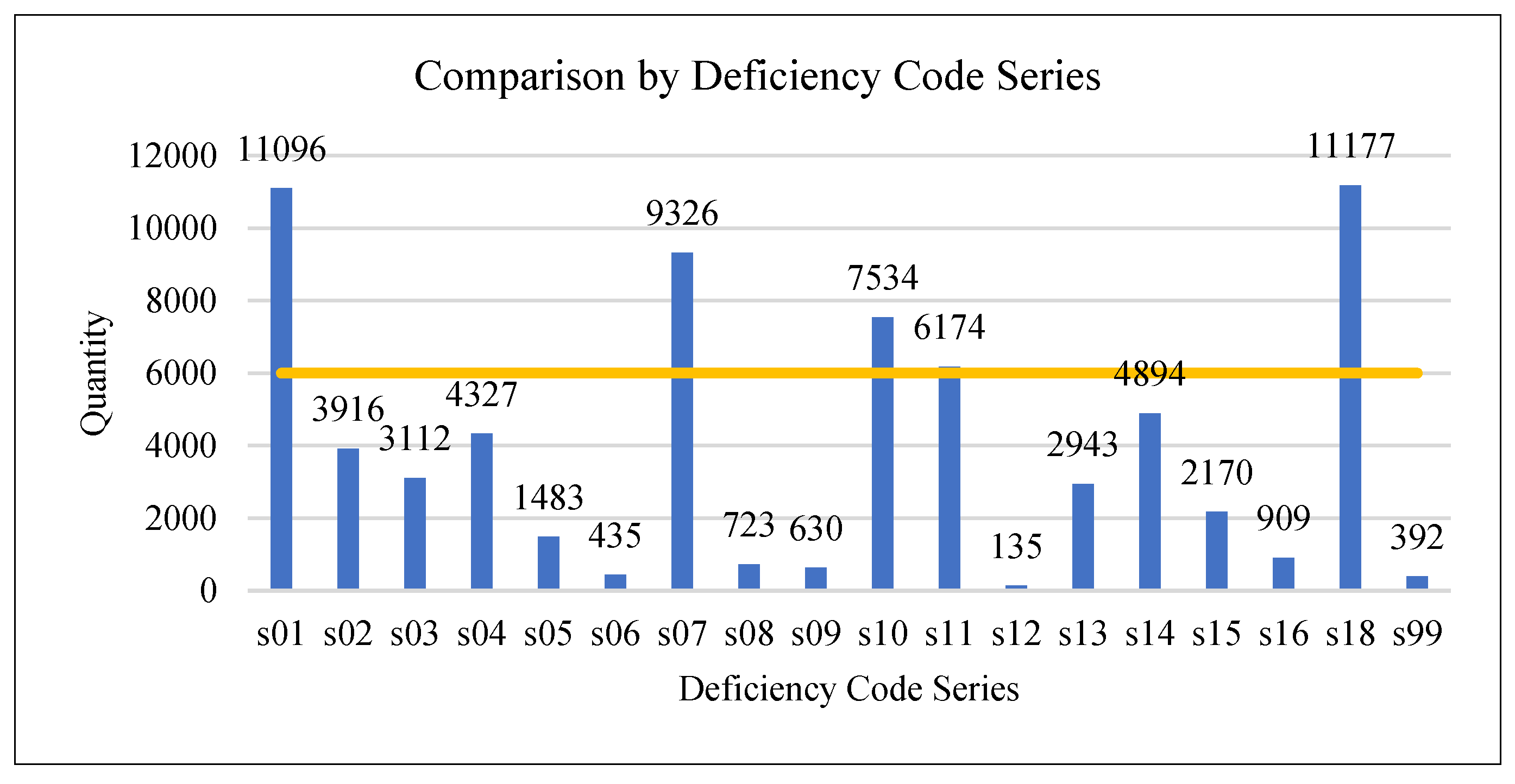

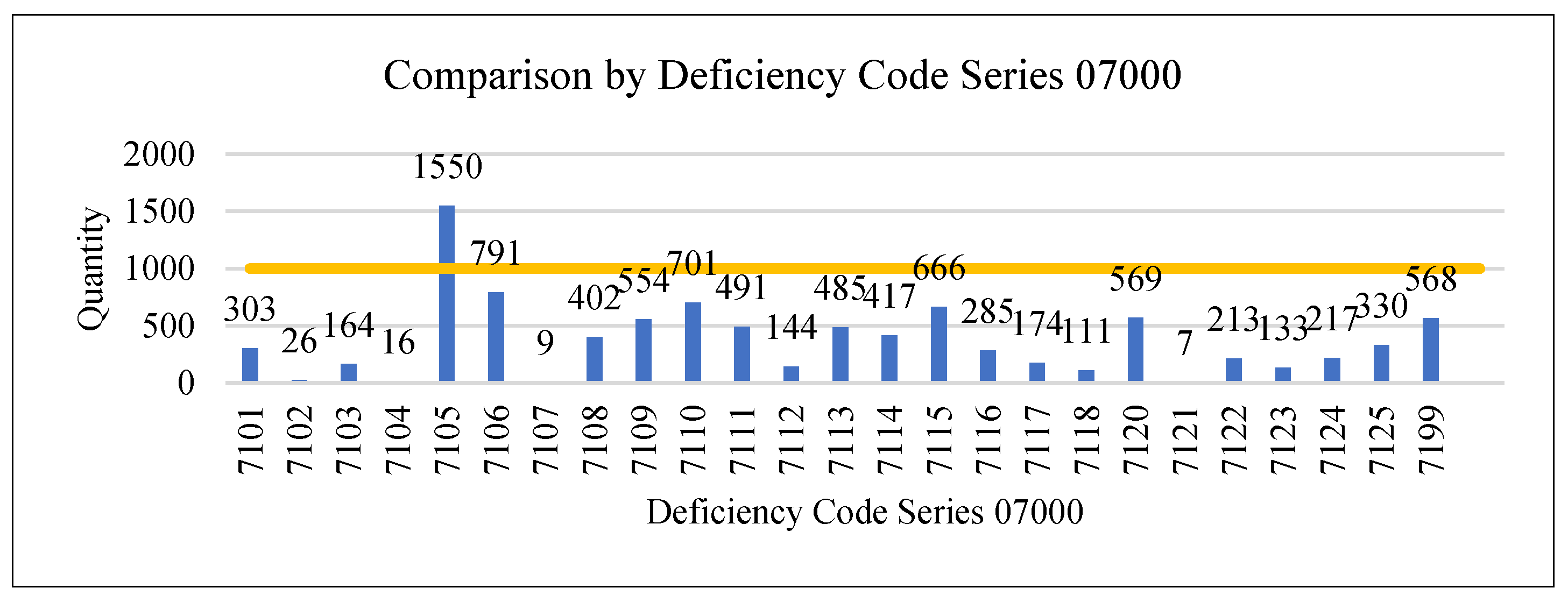
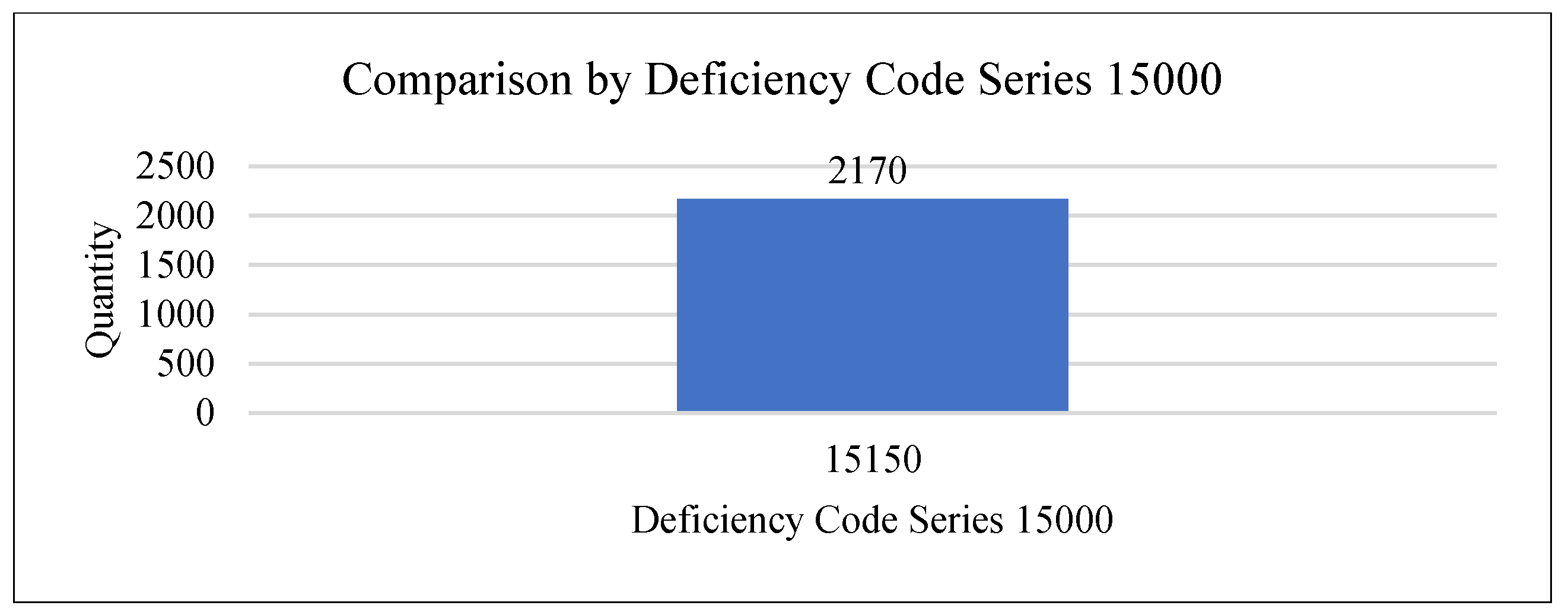
| Aspect from Section 2.1, Section 2.2 and Section 2.3, Section 2.4 and Section 2.5 | (1) | (2) | (3) | (4) | (5) | (6) | (7) |
|---|---|---|---|---|---|---|---|
| V | V | |||||
| V | V | |||||
| V | V | |||||
| V | V | |||||
| V | ||||||
| V | V | V | ||||
| V | V | |||||
| V | V | |||||
| |||||||
| |||||||
| V | ||||||
| V | V | V | ||||
| V | V | |||||
| V | V | V | V | V | V |
| Types | SUM | “15150” | “07105” | “01220” | “01315” | … | “18309” | “14808” |
|---|---|---|---|---|---|---|---|---|
| Bulk carrier | 14,149 | 419 | 224 | 149 | 111 | 0 | 0 | |
| Chemical tanker | 4780 | 218 | 163 | 79 | 52 | 0 | 0 | |
| General cargo/multipurpose | 25,816 | 731 | 451 | 222 | 343 | 1 | 0 | |
| NLS tanker | 86 | 4 | 2 | 0 | 0 | 0 | 0 | |
| Offshore supply | 1550 | 38 | 56 | 25 | 39 | 0 | 0 | |
| Oil tanker | 3429 | 103 | 80 | 53 | 31 | 0 | 0 | |
| Other | 3141 | 98 | 73 | 47 | 45 | 0 | 0 | |
| Container | 5873 | 202 | 150 | 41 | 65 | 0 | 1 | |
| Gas carrier | 1216 | 96 | 45 | 25 | 10 | … | 0 | 0 |
| Ro-Ro cargo | 2426 | 79 | 72 | 28 | 37 | 0 | 0 | |
| Other special activities | 2302 | 50 | 52 | 33 | 65 | 0 | 0 | |
| Ro-Ro passenger ship | 2123 | 46 | 54 | 8 | 23 | 0 | 0 | |
| Heavy load | 174 | 8 | 12 | 2 | 2 | 0 | 0 | |
| Tug | 1138 | 7 | 30 | 18 | 27 | 0 | 0 | |
| High speed passenger craft | 287 | 6 | 13 | 2 | 0 | 0 | 0 | |
| Gas Carrier/NLS tanker | 59 | 1 | 0 | 13 | 2 | … | 0 | 0 |
| Refrigerated cargo | 859 | 18 | 13 | 1 | 13 | … | 0 | 0 |
| Commercial yacht | 628 | 6 | 2 | 3 | 22 | 0 | 0 | |
| Special purpose ship | 465 | 10 | 25 | 12 | 11 | 0 | 0 | |
| Passenger ship | 849 | 29 | 32 | 5 | 17 | … | 0 | 0 |
| Combination carrier | 26 | 1 | 1 | 0 | 0 | 0 | 0 | |
| MAX | 25,816 | 731 | 451 | 222 | 343 | … | 1 | 1 |
| Rank | Types | Average |
|---|---|---|
| 1 | Bulk carrier | 0.850689 |
| 2 | General cargo/multipurpose | 0.814549 |
| 3 | Container | 0.814208 |
| 4 | Oil tanker | 0.739657 |
| 5 | Chemical tanker | 0.738650 |
| 6 | Other | 0.735002 |
| 7 | Ro-Ro cargo | 0.722863 |
| 8 | Gas carrier | 0.691105 |
| 9 | Other special activities | 0.689822 |
| 10 | Tug | 0.646232 |
| 11 | Offshore supply | 0.64502 |
| 12 | Ro-Ro passenger ship | 0.618565 |
| 13 | Special purpose ship | 0.617200 |
| 14 | High speed passenger craft | 0.611880 |
| 15 | Refrigerated cargo | 0.608326 |
| 16 | Heavy load | 0.549147 |
| 17 | Passenger ship | 0.530023 |
| 18 | NLS tanker | 0.499083 |
| 19 | Commercial yacht | 0.492268 |
| 20 | Gas Carrier/NLS tanker | 0.475004 |
| 21 | Combination carrier | 0.438254 |
| Rank | Types | Average |
|---|---|---|
| 1 | General cargo/multipurpose | 0.976351 |
| 2 | Bulk carrier | 0.970472 |
| 3 | Container | 0.963004 |
| 4 | Other | 0.959814 |
| 5 | Ro-Ro cargo | 0.957068 |
| 6 | Oil tanker | 0.956462 |
| 7 | Chemical tanker | 0.951627 |
| 8 | Offshore supply | 0.941492 |
| 9 | Passenger ship | 0.935249 |
| 10 | Other special activities | 0.934935 |
| 11 | Special purpose ship | 0.933020 |
| 12 | Tug | 0.929730 |
| 13 | Gas carrier | 0.926156 |
| 14 | Ro-Ro passenger ship | 0.923778 |
| 15 | Heavy load | 0.916794 |
| 16 | Commercial yacht | 0.914732 |
| 17 | High speed passenger craft | 0.914360 |
| 18 | Refrigerated cargo | 0.913073 |
| 19 | NLS tanker | 0.908497 |
| 20 | Gas Carrier/NLS tanker | 0.897012 |
| 21 | Combination carrier | 0.896094 |
| Rank | Codes | Average | Rank | Codes | Average | Rank | Codes | Average |
|---|---|---|---|---|---|---|---|---|
| 1 | “15150” | 0.882259 | 21 | “18407” | 0.760816 | 41 | “04109” | 0.733226 |
| 2 | “11117” | 0.832125 | 22 | “11104” | 0.760088 | 42 | “02117” | 0.728188 |
| 3 | “07120” | 0.822058 | 23 | “07106” | 0.754770 | 43 | “04114” | 0.727975 |
| 4 | “07105” | 0.820880 | 24 | “10109” | 0.753933 | 44 | “04102” | 0.727815 |
| 5 | “01315” | 0.808899 | 25 | “01214” | 0.753288 | 45 | “07124” | 0.727091 |
| 6 | “07115” | 0.801284 | 26 | “18414” | 0.753266 | 46 | “13103” | 0.726975 |
| 7 | “18408” | 0.799085 | 27 | “18302” | 0.752807 | 47 | “07109” | 0.726096 |
| 8 | “07199” | 0.792855 | 28 | “07114” | 0.752783 | 48 | “01307” | 0.725251 |
| 9 | “11108” | 0.791582 | 29 | “01220” | 0.751648 | 49 | “07116” | 0.725007 |
| 10 | “13101” | 0.790900 | 30 | “01101” | 0.751540 | 50 | “03105” | 0.723804 |
| 11 | “11113” | 0.785470 | 31 | “14501” | 0.747659 | 51 | “14802” | 0.723734 |
| 12 | “11101” | 0.784148 | 32 | “01308” | 0.745809 | 52 | “14499” | 0.723310 |
| 13 | “10111” | 0.782853 | 33 | “01113” | 0.745676 | 53 | “18319” | 0.723076 |
| 14 | “18416” | 0.774838 | 34 | “07113” | 0.745267 | 54 | “03102” | 0.717109 |
| 15 | “13102” | 0.768610 | 35 | “02199” | 0.741982 | 55 | “14801” | 0.714056 |
| 16 | “07110” | 0.768554 | 36 | “10127” | 0.741803 | 56 | “18318” | 0.713530 |
| 17 | “10104” | 0.768107 | 37 | “01218” | 0.740165 | 57 | “07101” | 0.711511 |
| 18 | “02108” | 0.761972 | 38 | “01199” | 0.738900 | 58 | “18499” | 0.711109 |
| 19 | “03103” | 0.761858 | 39 | “18324” | 0.738683 | 59 | “04103” | 0.710365 |
| 20 | “18313” | 0.760901 | 40 | “16105” | 0.734812 | 60 | “07122” | 0.709011 |
| ⁞ | ⁞ | |||||||
| 464 | “14103” | 0.433643 | 475 | “14609” | 0.431514 | 482 | “14799” | 0.428348 |
| 464 | “12103” | 0.433643 | 476 | “14203” | 0.431411 | 482 | “14303” | 0.428348 |
| 466 | “18307” | 0.433167 | 477 | “14808” | 0.431264 | 482 | “14809” | 0.428348 |
| 467 | “12112” | 0.432563 | 478 | “09103” | 0.430424 | 482 | “12110” | 0.428348 |
| 467 | “01134” | 0.432563 | 478 | “01216” | 0.430424 | 490 | “01110” | 0.427280 |
| 469 | “09135” | 0.432391 | 480 | “09204” | 0.428927 | 491 | “11133” | 0.425631 |
| 469 | “09211” | 0.432391 | 481 | “14805” | 0.428367 | 492 | “02124” | 0.424645 |
| 469 | “09225” | 0.432391 | 482 | “09229” | 0.428348 | 493 | “11114” | 0.424547 |
| 469 | “09114” | 0.432391 | 482 | “09203” | 0.428348 | 494 | “01109” | 0.422441 |
| 473 | “16104” | 0.431973 | 482 | “09206” | 0.428348 | 495 | “18323” | 0.418149 |
| 474 | “01114” | 0.431767 | 482 | “09205” | 0.428348 | 496 | “09128” | 0.416166 |
| Rank | Codes | Average | Rank | Codes | Average | Rank | Codes | Average |
|---|---|---|---|---|---|---|---|---|
| 1 | “10105” | 0.971696 | 21 | “03107” | 0.959328 | 41 | “18318” | 0.954995 |
| 2 | “07110” | 0.970277 | 22 | “04106” | 0.958633 | 42 | “99101” | 0.954947 |
| 3 | “03102” | 0.969109 | 23 | “07108” | 0.958493 | 43 | “18408” | 0.954821 |
| 4 | “11110” | 0.965909 | 24 | “07120” | 0.958175 | 44 | “10133” | 0.954707 |
| 5 | “13103” | 0.965067 | 25 | “11103” | 0.957791 | 45 | “07115” | 0.954619 |
| 6 | “03103” | 0.964983 | 26 | “02105” | 0.957702 | 46 | “11112” | 0.954529 |
| 7 | “11131” | 0.964694 | 27 | “04103” | 0.957180 | 47 | “14119” | 0.954420 |
| 8 | “02199” | 0.964545 | 28 | “11135” | 0.957104 | 48 | “04102” | 0.954132 |
| 9 | “11124” | 0.963770 | 29 | “02108” | 0.956930 | 49 | “10106” | 0.954106 |
| 10 | “04114” | 0.963370 | 30 | “14108” | 0.956869 | 50 | “07103” | 0.953825 |
| 11 | “07113” | 0.963130 | 31 | “16105” | 0.956640 | 51 | “14801” | 0.953558 |
| 12 | “15150” | 0.962783 | 32 | “10199” | 0.956563 | 52 | “18202” | 0.953156 |
| 13 | “07106” | 0.962043 | 33 | “10127” | 0.956447 | 53 | “07122” | 0.952757 |
| 14 | “01308” | 0.961535 | 34 | “11108” | 0.956336 | 54 | “05106” | 0.952081 |
| 15 | “18401” | 0.961523 | 35 | “07114” | 0.956065 | 55 | “11132” | 0.951936 |
| 16 | “01310” | 0.960573 | 36 | “04110” | 0.956041 | 56 | “18412” | 0.951903 |
| 17 | “04108” | 0.960437 | 37 | “01123” | 0.955609 | 57 | “18304” | 0.951851 |
| 18 | “08107” | 0.960203 | 38 | “13101” | 0.955553 | 58 | “18414” | 0.951744 |
| 19 | “18420” | 0.960069 | 39 | “02117” | 0.955444 | 59 | “02107” | 0.951495 |
| 20 | “10109” | 0.959835 | 40 | “10135” | 0.955011 | 60 | “05199” | 0.951426 |
| ⁞ | ⁞ | |||||||
| 453 | “04122” | 0.825578 | 472 | “08106” | 0.818593 | 486 | “09106” | 0.804397 |
| 453 | “11114” | 0.825578 | 473 | “01318” | 0.817575 | 487 | “01222” | 0.803823 |
| 460 | “07102” | 0.825402 | 474 | “12107” | 0.815656 | 488 | “01118” | 0.800513 |
| 461 | “01134” | 0.823698 | 475 | “14207” | 0.815409 | 489 | “01127” | 0.798910 |
| 462 | “09217” | 0.82352 | 476 | “12199” | 0.814502 | 490 | “01304” | 0.798170 |
| 463 | “12102” | 0.822867 | 477 | “01129” | 0.814380 | 491 | “14603” | 0.797558 |
| 464 | “12103” | 0.822545 | 478 | “01319” | 0.811815 | 492 | “01128” | 0.796049 |
| 465 | “01133” | 0.821836 | 479 | “01103” | 0.811040 | 493 | “11111” | 0.795195 |
| 466 | “09103” | 0.821262 | 480 | “01135” | 0.808900 | 494 | “08110” | 0.784433 |
| 467 | “09124” | 0.821226 | 481 | “01302” | 0.808434 | 495 | “01204” | 0.780940 |
| 468 | “04104” | 0.820098 | 482 | “09207” | 0.807725 | 496 | “10102” | 0.775295 |
| Ship Types | The Closeness of Each Experimental Combination to the Positive Ideal Solution | Rank |
|---|---|---|
| General cargo/multipurpose | 0.638937 | 1 |
| Bulk carrier | 0.467805 | 2 |
| Chemical tanker | 0.253551 | 3 |
| Container | 0.247554 | 4 |
| Ro-Ro passenger ship | 0.204797 | 5 |
| Oil tanker | 0.180508 | 6 |
| Other | 0.151059 | 7 |
| Ro-Ro cargo | 0.124089 | 8 |
| Other special activities | 0.120553 | 9 |
| Offshore supply | 0.097751 | 10 |
| Passenger ship | 0.095516 | 11 |
| Gas carrier | 0.091248 | 12 |
| Refrigerated cargo | 0.072103 | 13 |
| Tug | 0.069844 | 14 |
| High speed passenger craft | 0.067131 | 15 |
| Special purpose ship | 0.054843 | 16 |
| Commercial yacht | 0.048009 | 17 |
| NLS tanker | 0.032256 | 18 |
| Heavy load | 0.016328 | 19 |
| Gas Carrier/NLS tanker | 0.016098 | 20 |
| Combination carrier | 0.004070 | 21 |
| (A) Standard Deviation σ | (B) Deficiency Quantity | (C) Overall Deficiency Percentage | (D) Number of Deficiency Items Category | (E) Number of Discrepancies per Month (Deficiencies) | (F) Number of PSC Total Deficiencies per Month | (G) Awareness Differences | (H) Executive Consensus | |
|---|---|---|---|---|---|---|---|---|
| 1σ | 211.5172 | 49,654 | 69.57% | 110 | 5.8755 | 1379.2778 | 0.43% | 0.9957 |
| 2σ | 423.0344 | 30,140 | 42.23% | 46 | 11.7510 | 837.2222 | 1.40% | 0.9860 |
| 3σ | 634.5516 | 14,277 | 20.00% | 16 | 17.6264 | 396.5833 | 4.44% | 0.9556 |
| 4σ | 846.0688 | 4635 | 6.49% | 3 | 23.5019 | 128.7500 | 18.25% | 0.8175 |
| 5σ | 1057.5860 | 3720 | 5.21% | 2 | 29.3774 | 103.3333 | 28.43% | 0.7157 |
| 6σ | 1269.1031 | 3720 | 5.21% | 2 | 35.2529 | 103.3333 | 34.12% | 0.6588 |
| Ship Type | General Cargo/Multipurpose | Bulk Carrier | Container | Chemical Tanker | Oil Tanker | |
|---|---|---|---|---|---|---|
| PSC Code | ||||||
| (1) “15150” | 1 (731) | 2 (419) | 4 (202) | 3 (218) | 5 (103) | |
| (2) “07105” | 1 (451) | 2 (224) | 4 (150) | 3 (163) | 5 (80) | |
| (3) “04103” | 1 (274) | 2 (161) | 3 (73) | 4 (67) | 5 (66) | |
| (4) “01315” | 1 (343) | 2 (111) | 3 (65) | 4 (52) | 5 (31) | |
| (5) “10127” | 1 (318) | 2 (134) | 3 (58) | 4 (32) | 5 (31) | |
| (6) “07106” | 1 (269) | 2 (125) | 3 (79) | 4 (47) | 5 (31) | |
| (7) “13102” | 1 (224) | 2 (151) | 3 (74) | 5 (49) | 4 (50) | |
| (8) “01220” | 1 (222) | 2 (149) | 5 (41) | 3 (79) | 4 (53) | |
| (9) “11117” | 1 (314) | 2 (109) | 3 (60) | 4 (38) | 5 (20) | |
| (10) “13101” | 1 (251) | 2 (122) | 4 (70) | 3 (74) | 5 (21) | |
| (11) “11101” | 1 (207) | 2 (150) | 3 (64) | 4 (58) | 5 (54) | |
| (12) “07110” | 1 (284) | 2 (122) | 4 (42) | 3 (47) | 5 (34) | |
| (13) “10116” | 1 (276) | 2 (119) | 3 (53) | 5 (35) | 4 (40) | |
| (14) “10111” | 1 (349) | 2 (77) | 3 (46) | 4 (23) | 5 (22) | |
| (15) “07115” | 1 (214) | 2 (133) | 3 (58) | 4 (55) | 5 (41) | |
| (16) “18408” | 1 (236) | 2 (99) | 3 (81) | 4 (54) | 5 (18) | |
| Codes | Regulations | CIC Executive Year |
|---|---|---|
| 01000 | SOLAS, MARPOL, Tonnage 69, LL, ILO NO.147, COLREG, STCW | 2018, 2022 |
| 02000 | SOLAS, MARPOL, LL, Tonnage 69 | 2010, 2011, 2018, 2021 |
| 03000 | SOLAS, LL | Nil |
| 04000 | SOLAS, MARPOL | 2018, 2019 |
| 05000 | SOLAS (Ch.4) | Nil |
| 06000 | SOLSA, Tonnage 69 | Nil |
| 07000 | SOLAS, FSS Code | 2012, 2023 |
| 08000 | SOLAS | 2019 |
| 09000 | SOLAS, ILO No.147, 2006 MLC | 2014, 2016 |
| 10000 | SOLAS (Ch.5), COLREG | 2017 |
| 11000 | SOLAS (Ch.3), LSA Code | Nil |
| 12000 | SOLAS (Ch.7), MARPOL, IMDG Code | Nil |
| 13000 | SOLAS | 2013 |
| 14000 | MARPOL | 2018 |
| 15000 | SOLAS (Ch.9), ISM Code | Nil |
| 16000 | SOLAS (Ch.11-2), ISPS Code | Nil |
| 18000 | 2006 MLC | 2016 |
| 99000 | SOLAS, MARPOL | Nil |
| Rank | Type (Deficiencies Based) | Average | Types (Time Based) | Average |
|---|---|---|---|---|
| 1 | General cargo/multipurpose | 0.976351 | Bulk carrier | 0.850689 |
| 2 | Bulk carrier | 0.970472 | General cargo/multipurpose | 0.814549 |
| 3 | Container | 0.963004 | Container | 0.814208 |
| 4 | Other | 0.959814 | Oil tanker | 0.739657 |
| 5 | Ro-Ro cargo | 0.957068 | Chemical tanker | 0.738650 |
| 6 | Oil tanker | 0.956462 | Other | 0.735002 |
| 7 | Chemical tanker | 0.951627 | Ro-Ro cargo | 0.722863 |
| 8 | Offshore supply | 0.941492 | Gas carrier | 0.691105 |
| 9 | Passenger ship | 0.935249 | Other special activities | 0.689822 |
| 10 | Other special activities | 0.934935 | Tug | 0.646232 |
| 11 | Special purpose ship | 0.933020 | Offshore supply | 0.645026 |
| 12 | Tug | 0.929730 | Ro-Ro passenger ship | 0.618565 |
| 13 | Gas carrier | 0.926156 | Special purpose ship | 0.617200 |
| 14 | Ro-Ro passenger ship | 0.923778 | High speed passenger craft | 0.611884 |
| 15 | Heavy load | 0.916794 | Refrigerated cargo | 0.608326 |
| 16 | Commercial yacht | 0.914732 | Heavy load | 0.549147 |
| 17 | High speed passenger craft | 0.914360 | Passenger ship | 0.530023 |
| 18 | Refrigerated cargo | 0.913073 | NLS tanker | 0.499083 |
| 19 | NLS tanker | 0.908497 | Commercial yacht | 0.492268 |
| 20 | Gas Carrier/NLS tanker | 0.897012 | Gas Carrier/NLS tanker | 0.475004 |
| 21 | Combination carrier | 0.896094 | Combination carrier | 0.438254 |
Disclaimer/Publisher’s Note: The statements, opinions and data contained in all publications are solely those of the individual author(s) and contributor(s) and not of MDPI and/or the editor(s). MDPI and/or the editor(s) disclaim responsibility for any injury to people or property resulting from any ideas, methods, instructions or products referred to in the content. |
© 2023 by the authors. Licensee MDPI, Basel, Switzerland. This article is an open access article distributed under the terms and conditions of the Creative Commons Attribution (CC BY) license (https://creativecommons.org/licenses/by/4.0/).
Share and Cite
Lai, C.-Y.; Liu, C.-P.; Huang, K.-M. Optimization of the Concentrated Inspection Campaign Model to Strengthen Port State Control. J. Mar. Sci. Eng. 2023, 11, 1166. https://doi.org/10.3390/jmse11061166
Lai C-Y, Liu C-P, Huang K-M. Optimization of the Concentrated Inspection Campaign Model to Strengthen Port State Control. Journal of Marine Science and Engineering. 2023; 11(6):1166. https://doi.org/10.3390/jmse11061166
Chicago/Turabian StyleLai, Chiu-Yu, Chung-Ping Liu, and Kuo-Ming Huang. 2023. "Optimization of the Concentrated Inspection Campaign Model to Strengthen Port State Control" Journal of Marine Science and Engineering 11, no. 6: 1166. https://doi.org/10.3390/jmse11061166
APA StyleLai, C.-Y., Liu, C.-P., & Huang, K.-M. (2023). Optimization of the Concentrated Inspection Campaign Model to Strengthen Port State Control. Journal of Marine Science and Engineering, 11(6), 1166. https://doi.org/10.3390/jmse11061166






